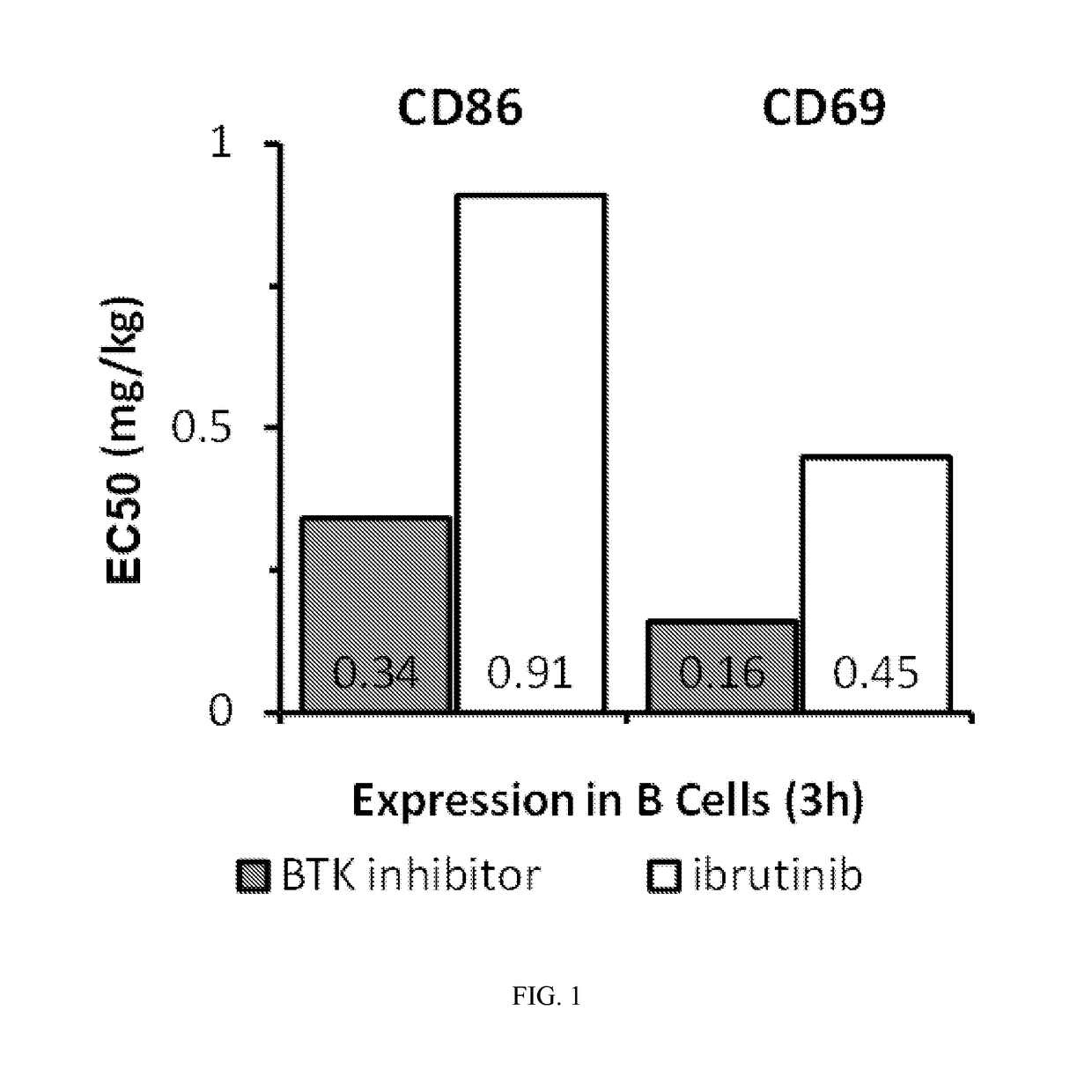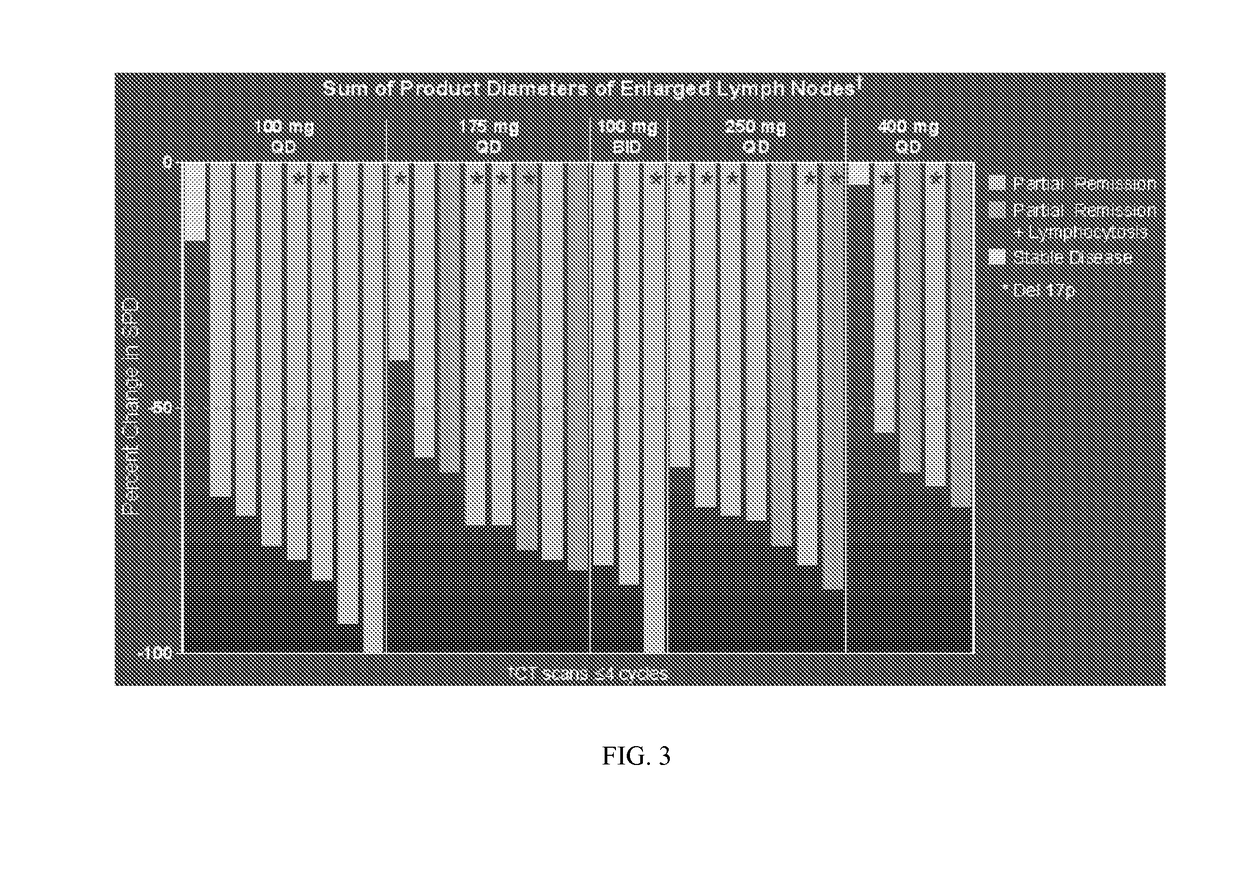Methods of Treating Chronic Lymphocytic Leukemia and Small Lymphocytic Leukemia Using a BTK Inhibitor
a lymphocytic leukemia and inhibitor technology, applied in the field of chronic lymphocytic leukemia treatment, can solve the problems of many standard treatments being associated with toxicities and immunosuppression, relapsed patients who receive standard treatments generally experience poor outcomes, and existing therapies may not eradicate residual malignant b cell populations in the microenvironment of the bone marrow. , to achieve the effect of increasing treg developmen
- Summary
- Abstract
- Description
- Claims
- Application Information
AI Technical Summary
Benefits of technology
Problems solved by technology
Method used
Image
Examples
example 1
Preclinical Study of a Second Generation BTK Inhibitor for Use in CLL / SLL
[0279]The BTK inhibitor ibrutinib ((1-[(3R)-3-[4-amino-3-(4-phenoxyphenyl)-1H-pyrazolo[3,4-d]pyrimidin-1-yl]piperidin-1-yl]prop-2-en-1-one) is a first-generation BTK inhibitor. In clinical testing as a monotherapy in subjects with hematologic malignancies, ibrutinib was generally well tolerated at dose levels through 840 mg (the highest dose tested). R. H. Advani, et al., J. Clin. Oncol. 2013, 31, 88-94; J. C. Byrd, et al., N. Engl. J. Med. 2013, 369, 32-42; M. L. Wang, et al., N. Engl. J. Med. 2013, 369, 507-16. No maximum tolerated dose (MTD) was apparent within the tested dose range. Furthermore, subjects typically found the drug tolerable over periods extending to >2 years. No subject had tumor lysis syndrome. No overt pattern of myelosuppression was associated with ibrutinib treatment. No drug-related reductions in circulating CD4+ T cells or serum immunoglobulins were noted. Adverse events with an apparen...
example 2
Clinical Study of a Second Generation BTK Inhibitor for Use in CLL / SLL
[0288]Clinical studies have shown that targeting the BCR signaling pathway by inhibiting BTK produces significant clinical benefit in patients with non-Hodgkin's lymphoma (NHL). The second generation BTK inhibitor, Formula (II), achieves significant oral bioavailability and potency, and has favorable preclinical characteristics, as described above. The purpose of this study is to evaluate the safety and efficacy of the second generation BTK inhibitor of Formula (II) in treating subjects with chronic lymphocytic leukemia (CLL) and small lymphocytic lymphoma (SLL).
[0289]The design and conduct of this study is supported by an understanding of the history and current therapies for subjects with lymphoid cancers; knowledge of the activity and safety of a first-generation BTK inhibitor, ibrutinib, in subjects with hematologic cancers; and the available nonclinical information regarding Formula (II). The collective data ...
example 3
Effects of BTK Inhibitors on Thrombosis
[0338]Clinical studies have shown that targeting the BCR signaling pathway by inhibiting BTK produces significant clinical benefit (J. C. Byrd, et al., N. Engl. J. Med. 2013, 369, 32-42; M. L. Wang, et al., N. Engl. J. Med. 2013, 369, 507-16). However, in these studies, bleeding has been reported in up to 50% of ibrutinib-treated patients. Most bleeding events were of grade 1-2 (spontaneous bruising or petechiae) but, in 5% of patients, they were of grade 3 or higher after trauma. These results are reflected in the prescribing information for ibrutinib, where bleeding events of any grade, including bruising and petechiae, were reported in approximately half of patients treated with ibrutinib (IMBRUVICA package insert and prescribing information, revised July 2014, U.S. Food and Drug Administration).
[0339]Constitutive or aberrant activation of the BCR signaling cascade has been implicated in the propagation and maintenance of a variety of B cell...
PUM
| Property | Measurement | Unit |
|---|---|---|
| Time | aaaaa | aaaaa |
| Time | aaaaa | aaaaa |
| Time | aaaaa | aaaaa |
Abstract
Description
Claims
Application Information
 Login to View More
Login to View More - R&D
- Intellectual Property
- Life Sciences
- Materials
- Tech Scout
- Unparalleled Data Quality
- Higher Quality Content
- 60% Fewer Hallucinations
Browse by: Latest US Patents, China's latest patents, Technical Efficacy Thesaurus, Application Domain, Technology Topic, Popular Technical Reports.
© 2025 PatSnap. All rights reserved.Legal|Privacy policy|Modern Slavery Act Transparency Statement|Sitemap|About US| Contact US: help@patsnap.com



